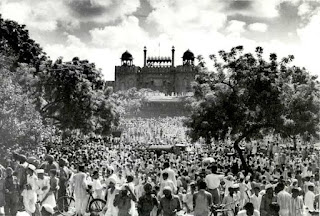The Quit India Movement 1942 : India's Defining Struggle for Independence
What is the Quit India movement?
The Quit India Movement, also known as the August Kranti or August Revolution, stands as a pivotal chapter in India's fight for freedom from British colonial rule. Born out of a collective resolve to attain complete independence, this movement of 1942 ignited the hearts of millions and reshaped the course of India's history. In this comprehensive exploration, we delve into the origins, key leaders, objectives, challenges, and the lasting impact of the Quit India Movement.
When was quit India movement started?
To understand the Quit India Movement, one must appreciate the historical context. By the early 1940s, India had already witnessed decades of resistance to British rule, including non-cooperation and civil disobedience movements led by leaders such as Mahatma Gandhi. However, the Second World War brought a new dimension to India's struggle for independence.
As World War II raged on, Britain's need for Indian support in the war effort intensified. The British government promised greater self-governance for India in exchange for its support, leading to the August Offer of 1940. However, this offer fell short of Indian expectations and was met with widespread disappointment.
Simultaneously, India's political landscape was marked by divisions among different groups and ideologies, making it imperative for leaders to find common ground for a unified struggle.
Key Leaders of the Quit India Movement
The Quit India Movement was marked by the active participation of several prominent leaders who played crucial roles in its organization and execution. Some of the key figures include:
Mahatma Gandhi: Gandhi, the father of the Indian independence movement, provided moral leadership and vision to the Quit India Movement. He called for "Quit India" and urged Indians to adopt non-violent means to achieve complete independence. Gandhi's unwavering commitment to non-violence inspired millions to join the struggle.
Jawaharlal Nehru: Nehru, a staunch advocate of socialism and democracy, played a significant role in the movement. His fiery speeches and writings galvanized the youth of India to participate actively in the struggle.
Sardar Vallabhbhai Patel: Patel, known as the "Iron Man of India," was a key organizer of the Quit India Movement in Gujarat. His leadership and organizational skills were instrumental in mobilizing people.
Rajendra Prasad: A prominent leader and the first President of independent India, Prasad actively participated in the Quit India Movement. His dedication to the cause made him an inspiration to many.
Objectives of the Quit India Movement
The Quit India Movement had clear and resolute objectives:
1. Complete Independence: The primary goal was the immediate and unconditional end of British colonial rule in India. This marked a departure from earlier movements, which had sometimes focused on gradual constitutional reforms.
2. Non-Violence: The movement emphasized the principle of non-violence, firmly rooted in the teachings of Mahatma Gandhi. Leaders and participants pledged to maintain non-violence even in the face of state repression.
3. Civil Disobedience: The movement called for mass civil disobedience, including non-cooperation with the British authorities, strikes, protests, and non-payment of taxes.
Challenges and Achievements
The Quit India Movement faced numerous challenges and achieved several milestones:
Challenges:
1. Repression: The British responded to the movement with a harsh crackdown, arresting prominent leaders and imposing curfews and censorship. The repression tested the resolve of the participants.
2. Divisions: The movement was not without internal divisions. Some leaders advocated a more militant approach, while others emphasized non-violence. Balancing these differing perspectives was a challenge.
3. Communication: The British effectively censored communication channels, making it difficult to coordinate and disseminate information about the movement.
Achievements:
1. Mass Mobilization: The Quit India Movement witnessed mass participation across the country. Ordinary citizens, students, and workers joined the call for independence.
2. Non-Violence: Despite the challenges, the movement largely maintained its commitment to non-violence, earning international admiration and support.
3. Shift in British Policy: The movement compelled the British government to reevaluate its stance on Indian self-rule. Realizing the strength of the Indian demand for independence, the British began to consider post-war plans for India.
Legacy and Impact
The Quit India Movement left a profound and enduring impact on India's struggle for independence and the subsequent course of history. Its legacy can be summarized in several key aspects:
1. Symbol of Unity: The movement was a testament to India's ability to come together across diverse backgrounds, ideologies, and regions for a common cause. It nurtured a feeling of national solidarity.
2. Commitment to Non-Violence: The movement underscored the efficacy of non-violence as a potent weapon in the fight for freedom. India's eventual independence was achieved largely through non-violent means.
3. Shift in British Policy: The movement forced the British government to recognize the inevitability of Indian independence. It marked a significant turning point in British colonial policy toward India.
4. Inspiration for Future Generations: The Quit India Movement inspired generations of Indians to stand up for their rights and participate actively in the political process. It laid the groundwork for a free and democratic India.
5. Emergence of New Leadership: The movement provided a platform for emerging leaders like Jayaprakash Narayan and Aruna Asaf Ali, who would go on to play influential roles in post-independence India.
Conclusion
The Quit India Movement, with its call to "Quit India" and achieve complete independence, remains a symbol of India's unyielding spirit in the face of colonial oppression. It demonstrated the power of non-violence, unity, and civil disobedience as tools for political change. The sacrifices made during this movement paved the way for India's eventual independence in 1947 and continue to inspire movements for justice, freedom, and human rights around the world. The August Kranti of 1942 will forever be remembered as a defining moment in India's journey towards self-rule and self-determination.





Post a Comment